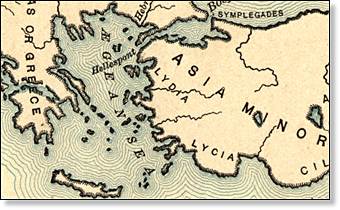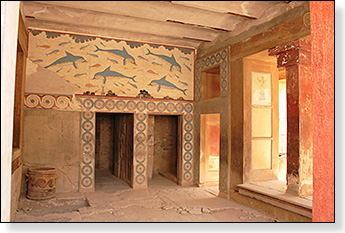
| A B C D E F G H I J K L M N O P Q R S T U V W X Y Z |

Lydia was on the coast of Asia Minor (modern Turkey).
|
| |
| Lydia (LID-ee-a). A region ruled in ancient times by King Croesus, centrally located in what is today Turkey. Croesus was a historical king of proverbial wealth, derived from gold deposits in the river Pactolus. These were said to have been left there when the legendary King Midas washed away the "Midas touch", the power to turn whatever he touched into gold. Lydia was also the home of the mythological Tantalus, who offended the gods and was condemned in Tartarus to eternal hunger and thirst, with water and fruit always just out of reach. |
| A B C D E F G H I J K L M N O P Q R S T U V W X Y Z |
|
|
|
|

|
L entries
|
|
| 
|
|
Labyrinth (LAB-i-rinth). A fiendishly intricate maze devised by Daedalus to house the Minotaur. The myth of an impossibly complex series of corridors may have been inspired by travelers' tales of the historical palace or temple compound of Knossos.
|
| Laconia (luh-KOH-nee-uh). A region of far southern Greece. Here at Taenarum was supposedly an entrance to Hades. When Theseus was convinced by his friend Peirithous to attempt the ill-fated abduction of Persephone, the Queen of the Dead, the two are said to have journeyed to the Underworld by means of a cave in Laconian Taenarum.
|
| Ladon (LAY-don). A many-headed dragon who watched over the garden of the Hesperides. When Heracles as one of his Labors sought the golden apples in the keeping of these Daughters of the Evening, he had to enlist the aid of the Titan Atlas. Atlas was willing to steal the apples if Heracles relieved him of his burden of holding up the heavens, but only if the hero first did something about Ladon. Heracles killed the dragon with an arrow over the garden wall.
|
| Lapiths (LAP-iths). A tribe in Thessaly, of whom at one point Theseus's friend Peirithous was king. It was at Peirithous's wedding feast that drunken centaurs attacked the Lapiths and also killed the supposedly invulnerable Caeneus by pounding him into the ground.
|
| Lerna (LUR-nuh). Village where the "Spring of the Hydra" is still pointed out today. Mythologically it was in the swamps of Lerna that Heracles, as one of his Labors, killed the many-headed Hydra. The bottomless Alcyonian Lake, through which the god Dionysus gained access to the Underworld to rescue his mother from the dead, was also in the vicinity of Lerna.
|
| Lethe (LEE-thee). A river in Hades whose waters caused forgetfulness. It was on the banks of another Underworld river called the Styx that the shades, or ghostly remains, of the dead congregated to seek passage to the Afterlife. Unless they bribed Charon to ferry them across the stream, they wandered aimlessly on the near bank forever. But those who made it across the Styx did not have much more to anticipate. Once they had drunk from the waters of Lethe, they were left with nothing to reminisce about for eternity.
|
| Lycia (LISH-ee-a). An ancient kingdom in Asia Minor (the Asian portion of modern Turkey). Mythologically, Lycia was beleaguered by the Chimaera, a fire-breathing monster that was part lion, part goat and part snake. Iobates, Lycia's king, sent Bellerophon after the beast in the expectation that the hero would never return. But with the help of the gods and the flying horse Pegasus, Bellerophon exterminated the Chimaera.
|
| |

Lydia was on the coast of Asia Minor (modern Turkey).
|
| |
| Lydia (LID-ee-a). A region ruled in ancient times by King Croesus, centrally located in what is today Turkey. Croesus was a historical king of proverbial wealth, derived from gold deposits in the river Pactolus. These were said to have been left there when the legendary King Midas washed away the "Midas touch", the power to turn whatever he touched into gold. Lydia was also the home of the mythological Tantalus, who offended the gods and was condemned in Tartarus to eternal hunger and thirst, with water and fruit always just out of reach. |
|
|